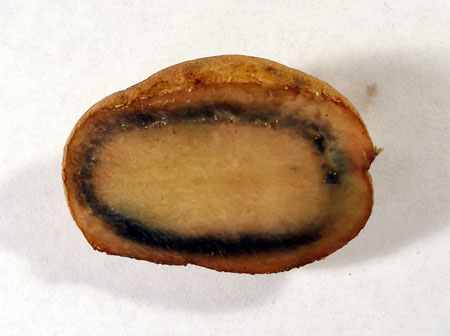Diseases
Ralstonia solanacearum (Smith) Jabuuchi et al. - Brown bacteriosis (Bacterial Wilt) of Potato.
Systematic position.
Kingdom Procaryotae, section Gram-negative aerobic rods and cocci, family Pseudomonadaceae, genus Pseudomonas.Synonyms.
Pseudomonas solanacearum Smith.Biological group.
Hemibiotroph.Morphology and biology.
The pathogen causes vascular disease of potato. First attributes of the disease are observed during flowering and formation of tubers. Plants unexpectedly wither, leaves shrink and droop, and the lower radical part of stem softens and rots. Typical attribute of this bacteriosis is stem splitting. The drops of bacterial exudate of brown color bleed from their cross-section. Later the bacteria penetrate into the stolons and young tubers, staining their vascular ring in brown color. The exudate excretes from tuber eyes and from places of stem attachment. The pathogen has 5 races, of which the 3rd one (low-temperature) is the most dangerous in the Russian Federation as it attacks potato. Cells of R. solanacearum are straight bacilli, usually 0.4-0.6 x 1.2-1.5 mkm in size, moving by means of polar flagella. Gram-negative. On potato agar colonies are gray, round, brilliant, smooth, transparent (later they become dark due to excretion of the melanin). Oxidase and catalase reaction is positive. Giving alkali on litmus milk. Not hydrolyzing starch. Diluting poorly or not diluting gelatin. Reducing nitrates. Hydrolyzing twins. Producing acid on media with carbohydrates in 3-5 days. Not forming indole, excreting H2S and NH3 irregularly. Optimum temperature for the 3rd biotype is 37°C, maximum 41°C, minimum 10°C, critical temperature 52°C. Sources of bacterial infection are the infected ground, vegetation residues, weeds of the genus Solanum, and tubers with the latent infection.Distribution.
This bacterial disease is found in the USA, Southern Africa, Sweden, Denmark, India, Japan, Philippines, New Zealand, Australia, and other countries. The bacteriosis meets in many regions of the Russian Federation; i.e., in the Leningrad, Moscow, Ekaterinburg, Voronezh, Kaliningrad Regions, in the Krasnodar Territory, Western and Eastern Siberia, Primorskii Territory, and also in Belarus, Latvia, and Ukraine.Ecology.
Active development of the bacteriosis is marked during vegetation seasons with the temperature 20-25C and with significant amount of precipitations.Economic significance.
The bacteriosis can cause significant economic damage. In some varieties, about 43% of plants are diseased and their yield decreases during vegetation by 40% in 3 years after accumulation of the infection; the storage losses can reach 50% and more. Up to 18% plants of the variety Slava are diseased in the Krasnodar Territory; the varieties Izora, Temp, Nevskii are strongly attacked in the Kaliningrad Region. The amount of infected plants of the varieties Izora and Nevskii is more than 8-10% in the Ekaterinburg Region. The amount of diseased bushes is 0.5-19.5% depending on a variety resistance in Belarus. The analysis of phytosanitary risk of this disease in territory of the Russian Federation shows that this bacteriosis is able to acclimatize in practically all zones of potato growing. The zone of the greatest danger is the Far East having monsoon climate, where yield losses may be maximal. The pathogen damage more than 200 species of cultural and weed plants. Control measures include maintenance of crop rotation, pesticide disinfection of tubers, cultivation of comparatively resistant varieties, landing high quality seed material, careful gathering and destruction of the vegetation residues, struggle against weeds. Precise serological tests are important for the pathogen diagnostics.Reference citations:
Avezdzhanova G.P. 1985. Bacterial diseases of potato at storage. In: Gvozdyak R.I., ed. Bacterial diseases of plants (Abstracts of reports). Part 2. Kiev: Naukova dumka, p. 59-60 (in Russian).Bermicheva N.S., Pletneva V.A. & Meshechkina Z.F. 1985. The lesion of potato by brown bacterial rot in Ural. In: Gvozdyak R.I., ed. Bacterial diseases of plants (Abstracts of reports). Part 2. Kiev: Naukova dumka, p. 61 (in Russian).
Bilai V.I., Gvozdyak R.I., Kraev V.G., Ellanskaya I.A., Zirka T.I. & Muras V.A. 1988. Microorganisms are the pathogens of diseases of plants. Kiev: Naukova dumka, 552 p. (in Russian).
Davidchik D.Ya., Khodos S.F. 1990. Bacterial diseases of potato and their pathogens in Latvia. In: Gvozdjak R.I., ed. Materials of conference. Phytoncides. Bacterial diseases of plants. Part II. Kiev & Lvov: KGT-2, p. 71 (in Russian).
Kuzmichev A.A., ed. 1994. Diagnostics of bacterial brown rot of potato and measures of its control. Methodical instructions. Moscow: Rossel.khozakademia, 40 p. (in Russian).
Matveeva E.V. 1994. Brown rot of a potato. In: Zakharenko V.A. & Matveeva E.V., eds. Proceedings of All-Russian Conference. Bacterial diseases of potato and vegetable cultures and methods of their control. Moscow: RASKHN, p. 17-23 (in Russian).
Pavlyushin V.A., ed. 1999. Methodical recommendations on research of bacterioses of tomato and potato and measures of their control. St. Petersburg: VIZR, 36 p. (in Russian).
Shklyar S.N. 1984. Bacterial withering of potato. Zashchita rastenii 5: 39 (in Russian).
Shneider E. Yu. & Sudarikova S.V. 2005. Quarantine bacterioses for Russia. In: Podgorskii V.S., ed. Collection of papers of participants of the International Scientific Conference. Phytopathogenic bacteria. Fytoncidology. Allelopathy. Kiev: Gosudarstvennyi Agroekologicheskii Universitet, p. 83-88 (in Russian).
Shneider Yu.I, Terent.eva, L.L. & Meshechkina Z.F. 1980. Brown bacterial rot of potato. In: Gorlenko M.V. et al., eds. Condition and prospects of development of scientific researches on prevention of resistance of pests and pathogens of diseases to pesticides and development of effectual measures of struggle against bacterial diseases of plants (abstracts of reports at IV meeting). Moscow: VASKHNIL, p. 71-72 (in Russian).
Sudarikova S.V. 2005. Brown rot of a potato - quarantine disease for the Russian Federation. In: Podgorskii V.S., ed. Collection of papers of participants of the International Scientific Conference. Phytopathogenic bacteria. Fytoncidology. Allelopathy. Kiev: Gosudarstvennyi Agroekologicheskii Universitet, p. 26-31 (in Russian).
Vasil.eva S.V. 1998. Brown bacterial rot. Zashchita rastenii 11: 34-35 (in Russian).
Vasyutin A.S., Levchenko V.I. & Sovershenova V.A. 2002. Atlas of pests, pathogens of plants and weeds having quarantine significance for the Russian Federation. In: Vasyutin A.S., ed. Moscow: Spetspechat, 136 p. (in Russian).
Zagurskaya L.E. & Sereda G.M. 1989. Distribution of bacterial diseases of potato depending on quality of seeds. In: Samersov V.F., ed. Proceedings of Belarus NIIZR. V. 14. Minsk: Urozhai, p. 39-41 (in Russian).


